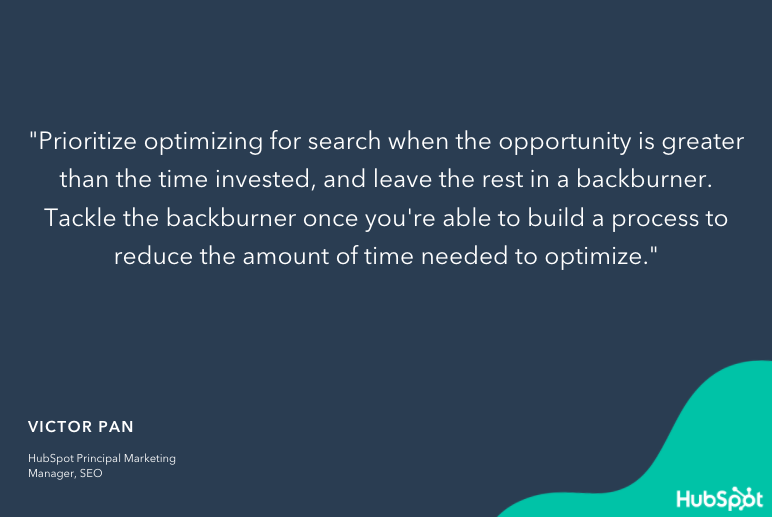
If you need help building a website, creating a company blog, or getting webpages discovered by search engines, there's plenty of SEO training that can help you get started.
But, once your website is built and your customers find your content online, how do you improve your search ranking and reach a larger audience?
While keyword research, overlap tests, and link-building, are a must for creating an online presence, there's much more you can do to increase the amount of traffic coming to your webpages.
That's why we spoke to experts on HubSpot's SEO team to learn how they've improved content strategy over time. Read on for a list of their tips that can help you rank higher on search engines and optimize the accessibility of your marketing campaigns.
How to Improve SEO Like HubSpot
1. Encourage visitors to search for your brand.
When your business is growing, it's important to increase the share of unbranded searches coming to your website. These are keywords that aren't specific to your brand, but they may be relevant to your industry.
For example, if you were a power-washing company located in Massachusetts, then you would want to rank for a search like, "best power-washing companies in New England." While the name of your company isn't included in this search, you would still want your website to appear in the search results when someone is looking for power-washing services in the New England area.

Once your company grows and develops stronger relationships with its customers, you can encourage branded traffic to your webpages. In fact, companies like Amazon have even influenced their buyers' search habits, and now its customers add "amazon" to their search queries when researching products on Google. This ensures that the top result on the SERP is most likely a link to an Amazon page.
Your company can have a similar effect on its customers by becoming a thought leader and resource for topics related to your industry. For instance, if customers had questions about how powerwashing works, its benefits, when you should do it, etc. then our powerwashing company might have a blog that answers all of these questions. As people read these articles and become familiar with our content, they might amend their search queries to include the name of our company so they can access our content faster.
2. Update your content.
Search engines are constantly updating their algorithms and improving their tools to provide better search results for their users. This means that your content can become outdated within months to a year and the keyword research that you did when you first created a piece may change as search engines adapt over time. That's why it's important to regularly update your content, so you can keep tabs on its performance and ensure it continues to rank high on search engines.

When updating content, you should replace old statistics and outdated terminology, and fill in any content gaps that you may have missed when you first created the piece. You should also fix any broken links or images and make sure that the formatting and branding is consistent with your current content. Do this at a cadence that makes sense for you — for many teams, it's every few months.
3. Analyze keywords beyond search volume.
When analyzing keywords, it's easy to locked in on search volume and prioritize keywords with the most potential traffic. However, it's important to look beyond just search volume and consider the intent of the keyword before you create content that's targeted towards it.
Open an incognito window and search for your keyword. Look at the content that's currently ranking for it and ask yourself if your content would fit with this SERP. If it doesn't, then it might be hard to rank for this topic with the content you're currently using.

Here's an example. Let's say our powerwashing company recently revamped its support team and we wanted to rank for the term, "progressive customer service." While we could write alot about our new and improved service team, we probably won't beat the insurance company, Progressive, from winning over this keyword. That's because the intent behind this keyword is for Progressive's service team and not for content related to the customer service industry.
4. Prioritize internal linking.
It's easy to grow organic authority when publishing content consistently, but it's just as easy to plateau if you don't consider where it should be published. This is a form of SEO "tech debt" that can hamper your growth the bigger your site gets.
To avoid this setback, it's important to audit your internal linking structure and identify different pieces of content that should be linked together. Adding links between internal pages helps search engines understand which content is related to one another as well as the keywords that these pages are targeting. It can also help Google index new pages faster if they're linked from the right pages to begin with.

You can use a number of SEO tools to systematically find these opportunities and update the pages that matter most to your sales efforts.
5. Form strong relationships with your developers and designers.
As your online presence grows, you might be surprised to find your SEO team is working closely with your web developers and designers. This is expected, though, since SEO is influenced significantly by how your content is designed and maintained.
The better relationship between your SEO team and web designers, the higher your content will rank. After all, if your web developers understand the importance of SEO, then they're more likely to listen to your SEO team's advice when creating and designing new content.

At the very least, open communication between these two teams can be the key to more consistent digital growth. For example, if your web developers want to delete a page that has 500 backlinks, they should first check in with your SEO team to see if there would be any negative repercussions. Effective communication between your developers and your SEO team can help you avoid SEO headaches and maintain high search rankings.
6. Prune content after long periods of growth.
Not all of your content is going to hit it out of the park — and, that's okay. Some content will fall shorter than expected and even though you update it, it might not obtain the amount of traffic you were originally hoping for.
As this content piles up, it can impact the speed and performance of your website. If it does, then you might want to consider pruning these pages so that they don't adversely affect user experience. Even though you'll forfeit a small amount of traffic from these pages, you'll likely save alot more by improving the user experience on your other, more popular pages.

7. Optimize Search-Friendly Content.
Not everything that you publish is going to be search-friendly — like ad landing pages, thank-you pages, internal sales enablement pages, and login pages. These pages aren't typically target by search engines and therefore aren't as important to optimize for search.
Instead, you should focus your attention on pages that are search-friendly. These are the ones that search engines are looking for and they play a much bigger role in the customer experience. If you can get this content in front of your target audience, they'll eventually discover your other pages as they continue to explore your site.

Optimizing Your Content Strategy
SEO is always a work in progress. So long as search engines continue to update their algorithms, marketing teams will have to create content that's not only relevant to their audience but can be easily discovered, too.
While SEO marketing software can help brands shape their content strategies, ultimately it will be up to marketers to create effective content that ranks high on search engines and attract new leads for their business.
For more ways to improve your content's search ranking, read these SEO tips.

By: [email protected] (Clint Fontanella)
Title: How HubSpot Content Strategists Improve SEO
Sourced From: Original article available: blog.hubspot.com/marketing/hubspot-seo-strategy
Published Date: 2021 02 04






